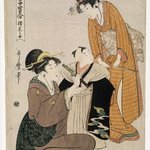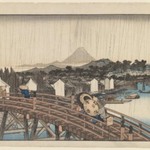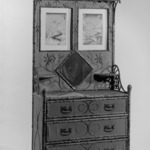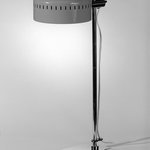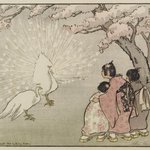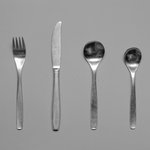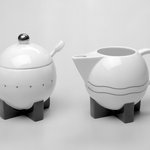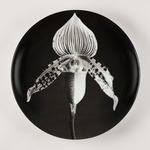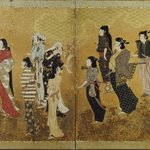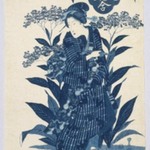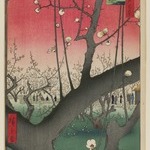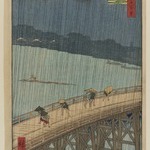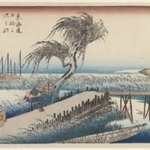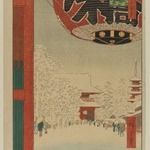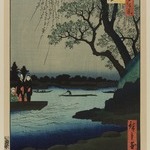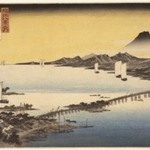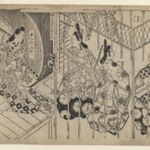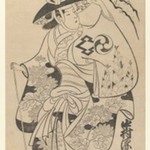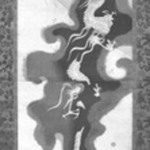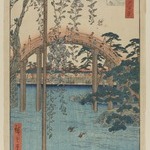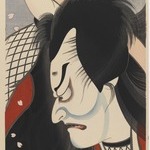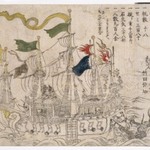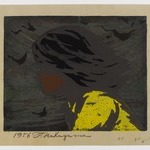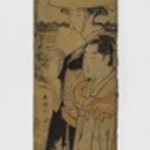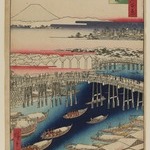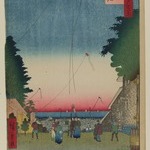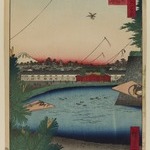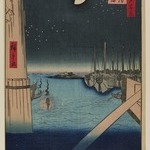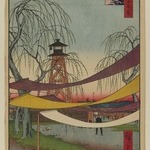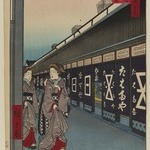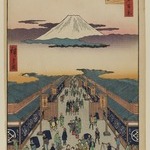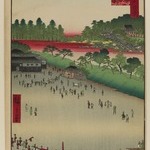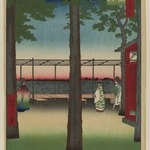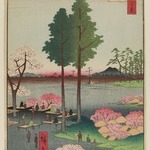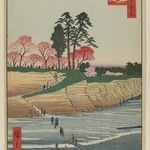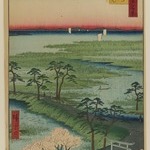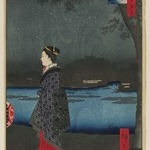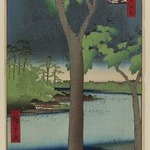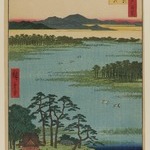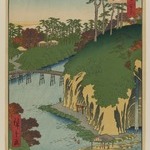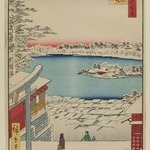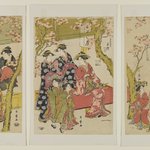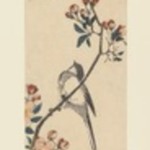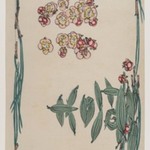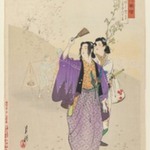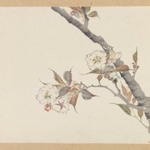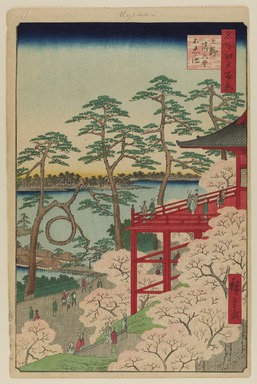
Kiyomizu Hall and Shinobazu Pond at Ueno, No. 11 in One Hundred Famous Views of Edo
Utagawa Hiroshige
Asian Art
Kiyomizu Hall in Ueno Park was founded in 1631 as part of an ambitious plan to establish a great Buddhist temple complex in Edo and to provide spiritual defense from the northeast, the direction from which evil spirits were thought to come. The hall is celebrated for the cherry blossoms in its vicinity and the view it offers. However, even in Hiroshige's day the actual panorama was less spectacular than is suggested by this print, which exaggerates the width of the veranda extending out from the temple and shows the pine trees as towering giants.
MEDIUM
Woodblock print
DATES
4th month of 1856
PERIOD
Edo Period, Ansei Era
DIMENSIONS
Image: 13 3/8 x 9 in. (34 x 22.9 cm)
Sheet: 14 3/16 x 9 1/4 in. (36 x 23.5 cm) (show scale)



SIGNATURE
Hiroshige-ga; publisher: Shitaya Uo Ei
COLLECTIONS
Asian Art
ACCESSION NUMBER
30.1478.11
CREDIT LINE
Gift of Anna Ferris
PROVENANCE
Prior to 1930, provenance not yet documented; by 1930, acquired by Anna Ferris of Summit, NJ; 1930, gift of Anna Ferris to the Brooklyn Museum.
Provenance FAQ
CATALOGUE DESCRIPTION
Scene shows the Shinobazu Pond in the center of Ueno Park; to the right amidst the cherry blossoms is Kiyomizu Hall, which remains known even today for the splendor of the cherry blossoms. The modern view is diminished by a row of multi-story buildings around the pond, but even in Hiroshige's day, the actual panorama was rather less spectacular than suggested in this print. The veranda extending out from the temple seems improbably wide and the pine trees, which appear in Hiroshige's own Ehon Edo miyage (vol. V) as reaching only up to the level of the veranda, are shown as towering giants. The Kiyomizu Hall was founded in 1631 as part of the ambitious plan of Tenkai - a Tendai priest and one of Tokugawa Ieyasu's chief mentors - to establish a great Buddhist temple complex in Edo which would be comparable in function to that of Enryakuji on Mount Hiei, northeast of Kyoto. The temple was named Toeizan ("Mount Hiei of the East") Kan'eiji (after its founding in 1625, the second year of the Kan'ei era, just an Enryakuji was founded more than eight centuries earlier and named for the Enryaku year period). Like its Kyoto counterpart, Kan'eiji was intended to provide spiritual defense of the city from the northeast, the dangerous direction whence evil spirits came. The Kiyomizu Hall was itself another example of Tenkai's tendency to replicate Kyoto in Edo as a way of bestowing legitimacy on the capital of the shogun. To the left is a small manmade island and here a small temple of Benten, goddess of water, was erected (see pl. 117). The curiously shaped pine at left, with its looped branch, was known as the "Moon Pine" and appears again in plate 89.
EXHIBITIONS
MUSEUM LOCATION
This item is not on view
CAPTION
Utagawa Hiroshige (Japanese, 1797–1858). Kiyomizu Hall and Shinobazu Pond at Ueno, No. 11 in One Hundred Famous Views of Edo, 4th month of 1856. Woodblock print, Image: 13 3/8 x 9 in. (34 x 22.9 cm). Brooklyn Museum, Gift of Anna Ferris, 30.1478.11 (Photo: Brooklyn Museum, 30.1478.11_PS20.jpg)
IMAGE
overall, 30.1478.11_PS20.jpg. Brooklyn Museum photograph, 2023
"CUR" at the beginning of an image file name means that the image was created by a curatorial staff member. These study images may be digital point-and-shoot photographs, when we don\'t yet have high-quality studio photography, or they may be scans of older negatives, slides, or photographic prints, providing historical documentation of the object.
RIGHTS STATEMENT
No known copyright restrictions
This work may be in the public domain in the United States. Works created by United States and non-United States nationals published prior to 1923 are in the public domain, subject to the terms of any applicable treaty or agreement.
You may download and use Brooklyn Museum images of this work. Please include caption information from this page and credit the Brooklyn Museum. If you need a high resolution file, please fill out our online application form (charges apply).
The Museum does not warrant that the use of this work will not infringe on the rights of third parties, such as artists or artists' heirs holding the rights to the work. It is your responsibility to determine and satisfy copyright or other use restrictions before copying, transmitting, or making other use of protected items beyond that allowed by "fair use," as such term is understood under the United States Copyright Act.
The Brooklyn Museum makes no representations or warranties with respect to the application or terms of any international agreement governing copyright protection in the United States for works created by foreign nationals.
For further information about copyright, we recommend resources at the United States Library of Congress, Cornell University, Copyright and Cultural Institutions: Guidelines for U.S. Libraries, Archives, and Museums, and Copyright Watch.
For more information about the Museum's rights project, including how rights types are assigned, please see our blog posts on copyright.
If you have any information regarding this work and rights to it, please contact copyright@brooklynmuseum.org.
RECORD COMPLETENESS
Not every record you will find here is complete. More information is available for some works than for others, and some entries have been updated more recently. Records are frequently reviewed and revised, and we welcome any additional information you might have.
